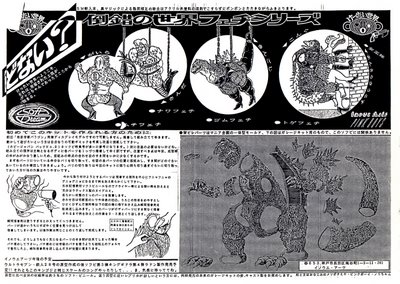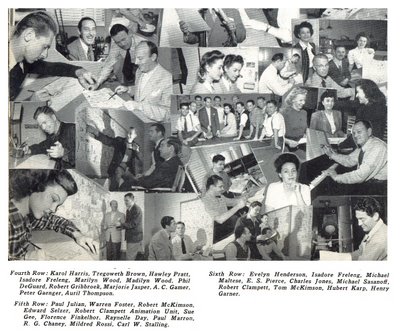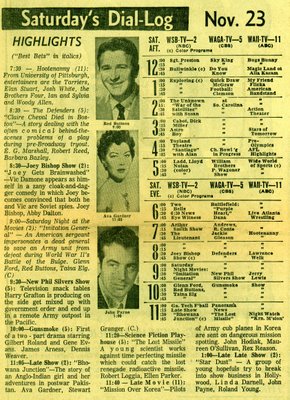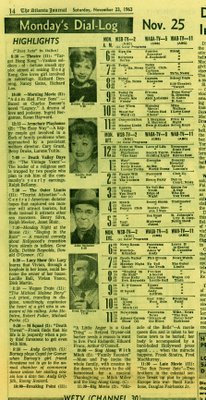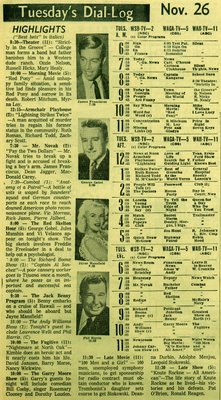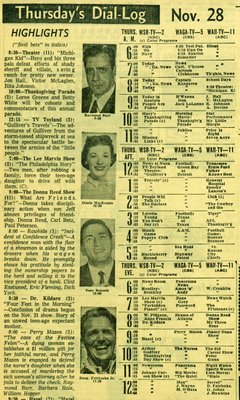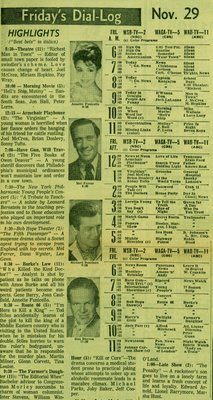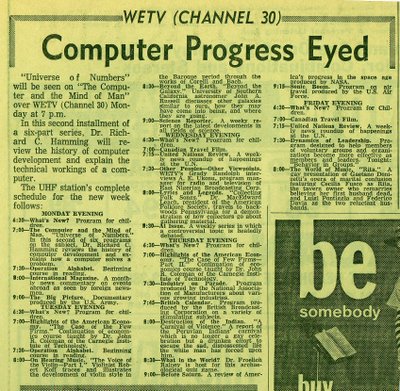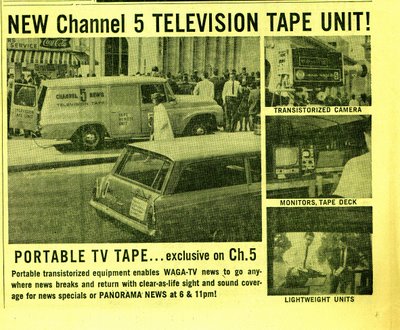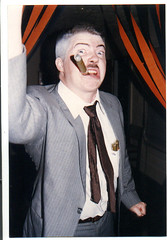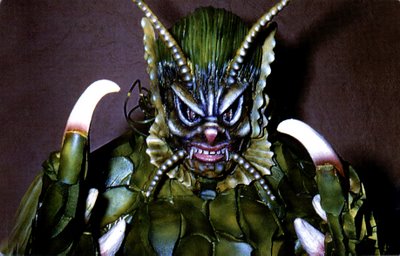 Paul Blaisdell! One of my heroes to be sure...and one of Hollywood's great unsung craftsmen as well. Paul was a true creative --few and far between in his field. He was the guy in Hollywood you called when you had practically no money and needed a miracle...and over and over, Paul delivered. His most recognized work was featured in 1950's Sci-fi movies like It Conquered the World, The She-Creature, Invasion of the Saucer-Men, Day the world Ended, Beast with a Million Eyes, and It, The Terror from Beyond Space.
Paul Blaisdell! One of my heroes to be sure...and one of Hollywood's great unsung craftsmen as well. Paul was a true creative --few and far between in his field. He was the guy in Hollywood you called when you had practically no money and needed a miracle...and over and over, Paul delivered. His most recognized work was featured in 1950's Sci-fi movies like It Conquered the World, The She-Creature, Invasion of the Saucer-Men, Day the world Ended, Beast with a Million Eyes, and It, The Terror from Beyond Space.
Since virtually all the films he worked on were shot in black & white, Here's some choice COLOR behind-the-scenes shots from a few of those films. First up and hopefully obvious, is Paul in the just-finished She-Creature costume. Paul played his creations himself more often than not, and this time around is no exception. Here he clowns around with Bob Burns' wife Kathy. (So where Bob at? --behind the camera, natch.)
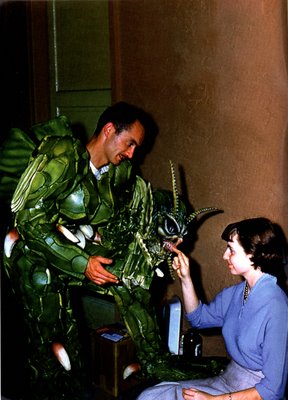

The "lunch hooks" on the costume's abdomen actually could open and close, but the effect was never utilized in the film.

The above shot was taken on the 100 foot suspension bridge that led to Paul's Topanga Canyon home. (How cool is that?) The bridge provided several close by photo-ops --As demonstrated by Paul and Bob Burns here posing as Drac and Frank underneath the very same bridge on a fun-filled Saturday night.

Bob Burns was Paul's good friend, fx assistant and cohort for many years and together they worked on a long list of films. Here's the two pals in 1957 with some of the props Paul built for Invasion of the Saucermen. (The wooden construct spaceship in the foreground reportedly required Paul to apply 100 coats of paint to get the desired smooth look!)
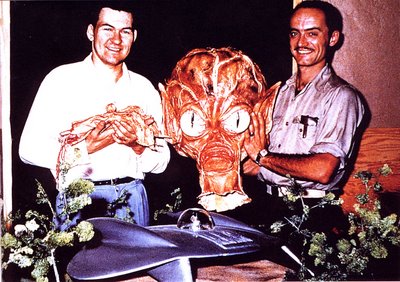 This truly inspired and exceptional 50's monster design inspired about a billion rip-offs. Paul put these babies together for pennies of what any big budget beastie would cost...and they're still pretty damn creepy some 50 years later! Talk about showmanship!
This truly inspired and exceptional 50's monster design inspired about a billion rip-offs. Paul put these babies together for pennies of what any big budget beastie would cost...and they're still pretty damn creepy some 50 years later! Talk about showmanship!


This shot is of an unused prototype of the Saucerman head. It was never actually intended for use in the film production.
I think it's way scarier looking with the smaller, sunken eyeballs rather than the buggy-veiny. This head definitely has more of a Gene Colan thing goin' on....
Paul made this 18 inch hand puppet (nicknamed "Little Hercules") for the climax of Roger Corman's The Beast with a Million Eyes for DIRT CHEAP!!
How cheap you ask?...try $400, punk!
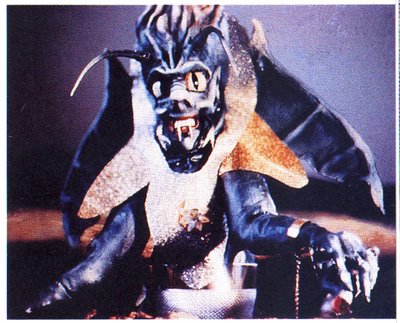 Paul designed The Tabonga the Living-Tree-spirit monster featured in From Hell It Came ...but he didn't build it the costume...and he was never paid for his work! So here's his designs in color, at least.
Paul designed The Tabonga the Living-Tree-spirit monster featured in From Hell It Came ...but he didn't build it the costume...and he was never paid for his work! So here's his designs in color, at least.
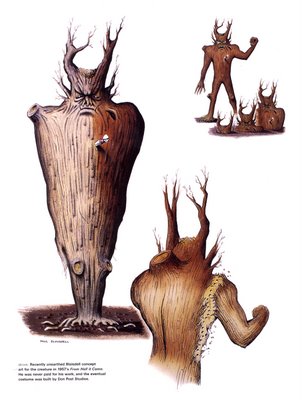 And bringin' up the rear, Pound for pound Blaisdell's best known work for sheer design insanity has to be BEULAH (As she was affectionately known) from 1956's It Conquered the World. Described as everything from a upside-down teepee to a 7-foot carrot monster, The image of Beulah has actually become pretty iconic. For years Creature Features in Burbank had a huge Beulah standee in their front window on Olive Ave. (I still can't believe I didn't bid on it when it sold it on eBay when they closed up a couple of years ago.) Here she is post-production, stored away in Paul's basement.
And bringin' up the rear, Pound for pound Blaisdell's best known work for sheer design insanity has to be BEULAH (As she was affectionately known) from 1956's It Conquered the World. Described as everything from a upside-down teepee to a 7-foot carrot monster, The image of Beulah has actually become pretty iconic. For years Creature Features in Burbank had a huge Beulah standee in their front window on Olive Ave. (I still can't believe I didn't bid on it when it sold it on eBay when they closed up a couple of years ago.) Here she is post-production, stored away in Paul's basement.
 All of the blue on Beulah is bounce-back from the floor (The same goes for the Saucerman portrait above, too). If you look close you can see one of the coaster wheels that the round-frame hoop-design suit rolled around on. I still kinda doubt that that promoted anything resembling smooth movement on the Bronson Canyon cave floor.
All of the blue on Beulah is bounce-back from the floor (The same goes for the Saucerman portrait above, too). If you look close you can see one of the coaster wheels that the round-frame hoop-design suit rolled around on. I still kinda doubt that that promoted anything resembling smooth movement on the Bronson Canyon cave floor.
Here, poor Paul appears to fall victim to him own creation. Imagine the irony.
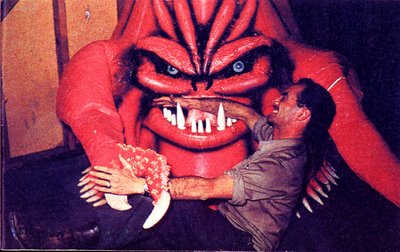 Ah, I gotta tell this --So, Paul was in the costume in this go-round too. (He had to "duckwalk" around inside of the costume in order to get it to move at all.) The eyes were affixed to flashlights --because "It" originally was supposed to stay back in the darkness of the cave and they wanted the eyes to glow-- so he could make the eyes appear to move by pushing the flashlight handles around. Paul also built the pincers on the long arms to actually work using a mechanism similar to bicycle brakes. The arms themselves, though cumbersome, were still capable of 180-degree arcs of movement. The overall effect was said to be uncannily lifelike. In fact, when AIP partner Jim Nicholson came in look at the full-size Beulah for the first time, Paul ducked under the costume, started working the controls and demostrated enough costume dexterity to pluck a hankerchief out of Nicholson's breast pocket with one of the pincers. Nicholson loved it. "Paul you've done it again!" he laughed." I never thought you'd come up with something this far out!"
Ah, I gotta tell this --So, Paul was in the costume in this go-round too. (He had to "duckwalk" around inside of the costume in order to get it to move at all.) The eyes were affixed to flashlights --because "It" originally was supposed to stay back in the darkness of the cave and they wanted the eyes to glow-- so he could make the eyes appear to move by pushing the flashlight handles around. Paul also built the pincers on the long arms to actually work using a mechanism similar to bicycle brakes. The arms themselves, though cumbersome, were still capable of 180-degree arcs of movement. The overall effect was said to be uncannily lifelike. In fact, when AIP partner Jim Nicholson came in look at the full-size Beulah for the first time, Paul ducked under the costume, started working the controls and demostrated enough costume dexterity to pluck a hankerchief out of Nicholson's breast pocket with one of the pincers. Nicholson loved it. "Paul you've done it again!" he laughed." I never thought you'd come up with something this far out!"
Okay, here's the part I'm getting to --once the crew got all assembled out at the Bronson Caves locale (located in the Hollywood Hills) somebody rolled a heavy equiptment-laden grip cart over Beulah's arms and totally wrecked the cable mechanisms! (And if you watch the movie close, it looks like that this little mishap just about tore the arms off as well!...they look really stressed in some scenes.) Sheez. Nowadays even a B-movie production would come to a halt until the title character could be repaired --but this was a Roger Corman production for the just-born AIP, dammit! The cave was rented for the day, they were already there, and by God, they had a picture to make! (That's why Beverly Garland has to sort of ...help Beulah's claw grab her by the throat, though . Ah, well...)
 Paul died in 1983 after a long and excruciating battle with cancer. A pity he never lived to see the outpouring of appreciation for his work that was yet to come, set off largely in 1990 by both a cover story on him by Cinefantastique magazine, and the release of several model kits based on his creations to America by Billiken U.S.A. Amongst the kit releases were "IT" (Beulah), The She-Creature, The Colossal Beast, and the Saucerman.
Paul died in 1983 after a long and excruciating battle with cancer. A pity he never lived to see the outpouring of appreciation for his work that was yet to come, set off largely in 1990 by both a cover story on him by Cinefantastique magazine, and the release of several model kits based on his creations to America by Billiken U.S.A. Amongst the kit releases were "IT" (Beulah), The She-Creature, The Colossal Beast, and the Saucerman.
Since I have a few Paul and Bob tributes at my house ...Here's my own big Beulah kit in the upstairs corner display room. Hope you enjoyed this bit-o Hollywood history (and a wall of thanks to Bob Burns for all the behind-the-scenes photos).
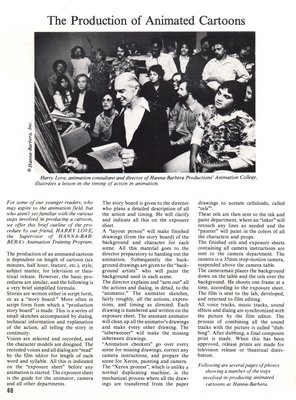
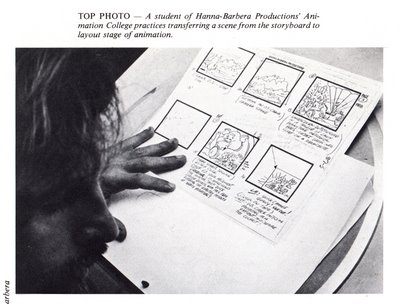
 Wow, check out all the "That '70's Show" fashions and hair in this shot. (Looks like my High school annual actually...)
Wow, check out all the "That '70's Show" fashions and hair in this shot. (Looks like my High school annual actually...) Now what character is this...and who's he designing? (Kinda looks like George Clooney on the right.)
Now what character is this...and who's he designing? (Kinda looks like George Clooney on the right.)
 "Animator" hell! Isn't that the great Carlo Vinci animatin' classic Flintstone here? (This shot obviously came from deeper in the archives --just look at the cars in the parking lot outside!)
"Animator" hell! Isn't that the great Carlo Vinci animatin' classic Flintstone here? (This shot obviously came from deeper in the archives --just look at the cars in the parking lot outside!)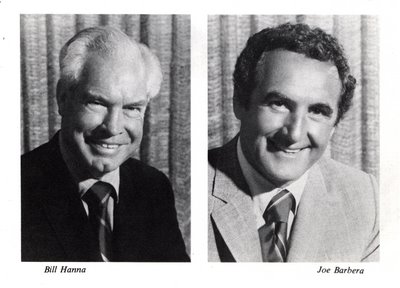 Cartoon geniuses still in their prime.
Cartoon geniuses still in their prime.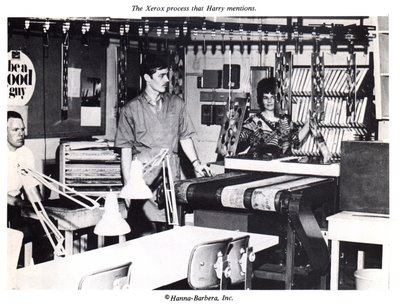 Today's generation of animation student might well wonder what any of the equipment in this room is actually used for.
Today's generation of animation student might well wonder what any of the equipment in this room is actually used for.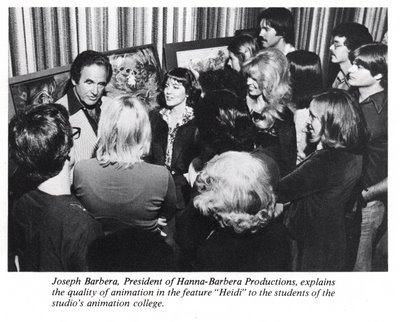 Joe, here apparently wearing John Travolta's suit from Saturday Night Fever, keeps 'em enthralled! (Yet another fine group of animation students on the road to wealth and fame!)
Joe, here apparently wearing John Travolta's suit from Saturday Night Fever, keeps 'em enthralled! (Yet another fine group of animation students on the road to wealth and fame!) Ah, one of the lovely ink-and-paint girls! Anybody know who this is? (I'm guessing this is probably an older shot too, since the character on the cel she's holding up looks suspiciously like ol' Injun Joe from 1968's The Adventures of Huckleberry Finn.)
Ah, one of the lovely ink-and-paint girls! Anybody know who this is? (I'm guessing this is probably an older shot too, since the character on the cel she's holding up looks suspiciously like ol' Injun Joe from 1968's The Adventures of Huckleberry Finn.)